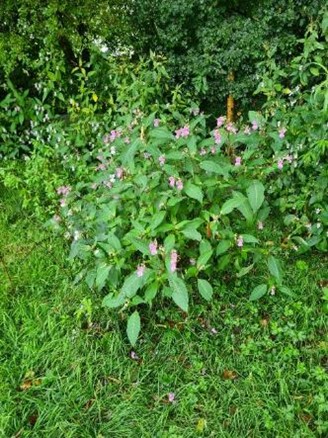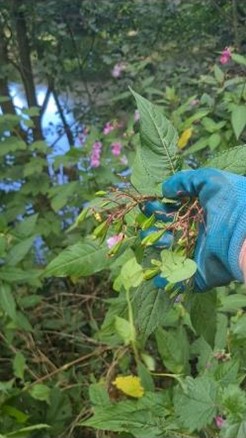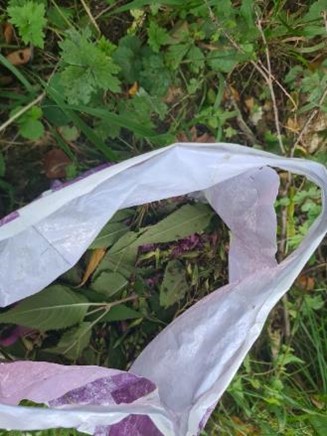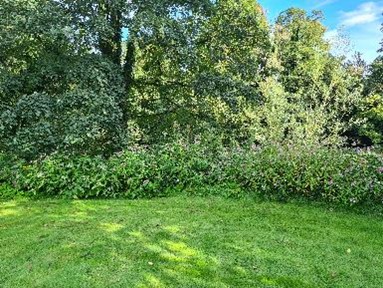One question that’s been brought up this year is ‘shouldn’t you leave Himalayan Balsam (HB) once it’s gone to seed?’
With anything in life, the answer isn’t a straightforward yes or no. Once HB has started to form its mature seed pods it should be treated more carefully. So, here is our handy information pack about the methods we use, when and why to pull HB in seed, the risks and how to reduce them.

Our Method: How to conduct a balsam bash when HB has seed pods
- Take a thick plastic bag and a pair of scissors.
- Approach the plant, and carefully clear any surrounding strands of vegetation such as brambles or fern fronds, from around the HB head you are targeting. It’s amazing how often a seed head will snag on a neighbouring plant, triggering a release of seed.
- Next, grab the seed head near the top of the plant where the seed pods are, gently bend the head of the plant with all its pods into the bag. Try to avoid rapid movements as this can cause the pods to start pinging off the plant. When the head of the plant is in the bag cut off the head of the plant. Once the pods are in the bag you can the pull up the plant in the usual fashion.
- Now pull the headless plant, snapping off root as close to where the root starts as you can and leave the plant to wither by hanging or in piles on the ground. TIP: Stomping on them helps ensure they don’t resprout.
The bag of seeds can be dealt with in different ways. Please always check the gov.uk guidance for disposal:
https://www.gov.uk/guidance/prevent-the-spread-of-harmful-invasive-and-non-native-plants
- If the site you’re tackling has a fire, you can put them on that (a permit may be required). Be aware that the seeds can be ejected from the fire, that’s why it’s important that fires are done in the vicinity of the balsam area. You can then make checks for new growth around the fire area in subsequent years. Seeds that do manage to escape however are few and far between.
- The other method of dealing with the seeds is to find a location within the balsam area that is:
- dry and prominent;
- not going to be part of a water course or flood area;
- is readily accessible and visible (i.e. somewhere very close to where you normally park or gain access to the area)
When you’ve located a suitable spot, tip the bag of seeds out into one pile. You may want to use this same site later in the year or in subsequent years, so choose well and remember the location! (Landowner permission should be sought too). In our volunteer’s experience, few seeds germinate from these piles. But do keep an eye on the area to ensure no balsam plants are growing.
One thing to always to bear in mind – seeds shouldn’t be removed from site. This can lead to HB spreading into unaffected areas. Prevention is key!
This form of pulling takes a lot of time and care. If you are confronted with a large stand of plants ready to pop, it may not be feasible to use this approach.



When and why: Removing HB in seed.
1.Is the area under constant HB management?
If the area has been consistently managed from the start of the season, returning and making sure there are no plants, the goal is to eventually eradicate it from that location. So even if it has plants with seed pods, these should be removed.
2.Are there only a couple of plants?
If you have found a new area with a couple of plants, it might be prudent to pick these when they’re starting to create seed pods. This is an opportunity to stop balsam forming in this location from the very beginning, otherwise following years will see more plants.
3.Is this effective mitigation?
If you want to start balsam control but aren’t able until late in the year, reducing the number of seeds not only helps reduce the amount of viable seeds but also enables you to be in control of where they land. This helps stop them from entering more troublesome areas and water courses.
What are the risks and how to reduce them?
1.Seeds popping when you are trying to deal with them.
They will pop anyway but you might be reducing the impact by removing them.
2.Seeds landing on you.
This is a much bigger risk. Although you can’t stop them falling on you, you can take appropriate measures to ensure all seeds are left on site. Wear clothes with smooth surfaces, such as waterproofs. Check crevices, such as where your ankle and shoe meet. Seeds in footwear can be reduced by wearing waterproofs over wellies. Check all the shoe for seeds (top and bottom). Shake out your hair to dislodge any seeds (or better, wear a hat).
3.Seeds in disposable bag used for collecting.
When emptying the seeds (see methods), make sure that all seeds are removed from the bag, you can wash the bag out on site to be sure. Store the bag carefully and only use for Himalayan balsam related activities. Before getting rid of the bag make sure it is completely clear of seeds or plant material.
You should also be aware of when HB comes into seed. It can vary massively, dependent on a number of factors. These include:
- Seasonal weather – cold will delay growth, warmth will encourage growth;
- Sunlight – plants growing in area with lots of sunlight will grow faster than those in shadier spots (such as in woodland);
- Time of germination – plants start germinating in spring and continue until September, sometimes later, depending on the factors listed above. An early germinating plant will be setting seed in late June/July, whereas a late germinating plant, in a shady spot for example, may not be ready to pop until September.
Each area HB is in, and the type of management strategy dictates how seeding plants are dealt with. A dynamic risk assessment can help here.
In areas that are managed regularly, plants can still be pulled though until November. It’s always best to tackle HB before it seeds but life is hectic and getting back to the patches of balsam as regularly as you’d like is not always possible. Spotting plants when bracken is high or brambles cloak them is well-nigh impossible. With a bit of persistence and a systematic approach, it’s possible to eradicate the plants completely from an area. Do what you can – ask for help if you need it – and be as consistent as possible.
Written by our local volunteer Balsam Bashing co-ordinator and Sammy Graves (SCRT INNS Co-ordinator).
Successes
A couple of before and after photos of a patch successfully cleared of seeding balsam. It is close to the river. The removed seeds were burned on site. This means there will be a reduction of potential plants in the coming years and less seeds to go into the water. This site is now down to be strimmed in June next year, before the seeds even begin to appear. And perhaps next year I’ll work on getting before and after shots a bit more precise.






If you fancy giving it a bash (get it) come join us next year. Just drop me an email at sammy@scrt.co.uk
